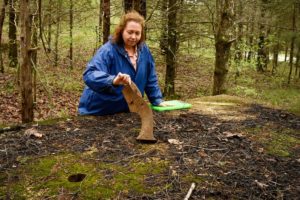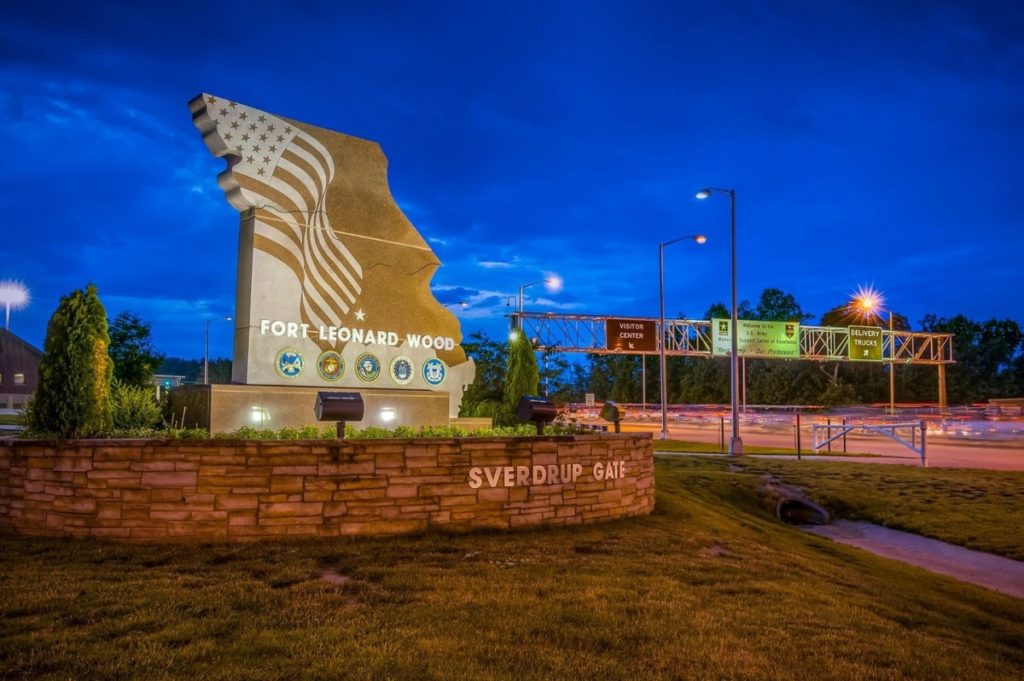Amanda Sullivan
FORT LEONARD WOOD, Mo. (May 16, 2022) No need to hop in a Delorean to travel through time on Fort Leonard Wood.
Thanks to the Directorate of Public Works Natural Resources Branch’s Cultural Resources Program — responsible for preserving and protecting more than 700 archeological and cultural sites on the installation — the history of Fort Leonard Wood lands, and the stories of the people who called this area home, stays alive.
“We feel it is important to preserve our history and our heritage, and save and preserve the things that are significant, whether it be physical or tangible representations of our history, or a type of architecture or an event or activity that happened here,” said Cultural Resources Program Coordinator and Archeologist Stephanie Nutt.
Pre-historic times
It may not be evident while driving around the installation today, but archeological evidence suggests human occupation of this area since pre-historic times, according to Andrew Phillips, an archaeologist with the Cultural Resources Program, who specializes in prehistory.
Of the 700 or so archeological and cultural sites on the installation, 400 are considered prehistoric. The oldest artifact found on Fort Leonard Wood land since the Army took over preservation efforts almost 82 years ago, was a Dalton point — a projectile point used for hunting — that dates back about 10,000 years.
Preservation of archeological sites — and the artifacts found within them — have, and continue to, further knowledge about prehistoric times in this area.
Perhaps Fort Leonard Wood’s most significant prehistoric discovery over the past 80 years, according to Phillips, was cave complexes, significant rock shelters and prehistoric habitation sites on the installation.
“Historically, archeologists called this area the ‘barren quarter,’ because they thought there wasn’t a lot going on here during prehistoric times,” Phillips said. “Archeology on Fort Leonard Wood has proven them wrong. If we didn’t have these sites, we wouldn’t know anything.”
Phillips said the context of the site is crucial to telling the story of the people who lived there.
“Without context, the artifact means nothing,” Phillips explained. “The context of a site, or building, tells you about the people who lived there, worked there or used the land, which is what we want to know.”
Pre-Fort Leonard Wood
Prior to the days of marching troops and the nightly sound of Retreat, several towns occupied the land here before the Army purchased it in 1940. Nutt said a lot of people think everything from those days is gone because the Army is here now, but that is not the case.
She said she hopes the local community knows that Fort Leonard Wood really cares about the area’s history, and has tried to preserve it, but preserving buildings, structures and archeological sites is only part of the preservation process.
According to Nutt, not all buildings, structures and sites can be saved — but their story can, through research, investigation and documentation.
“Preservation does not mean saving everything, or freezing things in time,” Nutt said. “It’s about capturing what life was like, and how those people were living their lives. Even when we can’t preserve the physical site or building, we can still preserve the history through records, photographs and the documentation. Those things are just as important and meaningful to us.”
When researching a site, Nutt tries to piece together the story of the location, sometimes including who lived there, their occupation or how many children they had.
“You can piece a lot together from a census record,” Nutt said. “It’s like a 10-year snapshot.”
For sites where field work has been conducted, Nutt said she has done genealogy on the family, researched the land records and knows who owned it and who sold it.
Every once in a while, they have the opportunity to bring the story full circle.
“Sometimes, we have the pleasure of bringing those people on post and taking them to the place where they lived when they were a child, or where their parents or grandparents lived,” Nutt said. “It’s incredibly rewarding to stand with those people, at this place that is the tangible reminder of their family, and give them the opportunity to do that.”
World War II era
The land Fort Leonard Wood sits on was purchased by the federal government in late 1940, and construction on what was then called the Seventh Corps Area Training Center began on Dec. 3, almost exactly one year before the Japanese attack on Pearl Harbor that helped launch the United States into World War II. It was designated Fort Leonard Wood in January 1941.
During the war, the installation housed close to 5,000 prisoners of war, who were responsible for stonework that can be seen around the installation, including at ranges, training areas and cemeteries.
“You’ll see it as you’re driving around,” Nutt said. “They were building things everywhere. A lot of it is still functioning and still doing the infrastructure job it was built to do over 70 years ago.”
Architectural surveys have been conducted to inventory and evaluate the POW stonework features across the installation, and determine their significance.
“The stonework is a big part of the World War II history of Fort Leonard Wood,” Nutt said. “That is worthy of preserving and learning about.”
Vietnam War era
Those who served or trained here during the Vietnam War may feel more at home than they might expect when they pass by what’s called the 600 Area Rolling Pin Barracks historic district.
The district is bounded by Iowa Avenue, Fourth Street, Buckeye Avenue and Minnesota Avenue, and includes barracks, administrative buildings, a chapel, a fitness center and a post exchange.
Constructed between 1961 and 1966, the buildings in the district may appear non-descript and like many other areas on Fort Leonard Wood, with their red-brick exteriors, but 23 of the buildings hold a significant architectural history that makes the location eligible to be included in the National Register of Historic Places.
By the early 1960s, Nutt said Fort Leonard Wood was growing, and the Army was moving away from the World War II temporary buildings in favor of permanent structures. The barracks were the first permanent, unaccompanied personnel housing on Fort Leonard Wood, and built using standardized plans designed specifically for the military.
Fort Leonard Wood was the first Army installation to have them constructed, but, according to Nutt, that isn’t the only thing that made them historically significant.
Two other versions of the design were released in the following years, and Fort Leonard Wood is the only installation to have them all.
“This is the only installation with all three styles,” Nutt said. “It’s very subtle, but you can see the differences in the design, and that’s why those were singled out.”
The buildings are still used today, Nutt said.
“We are trying to make those things functional and usable, so they will survive for generations,” she added. “That’s what makes it last 50 or 100 more years — they need to be viable, functional resources that support our daily activities — in our case, support the mission activities.”
It’s about responsibility
Federal laws like the Antiquities Act of 1906, Historic Sites Act of 1935, and National Historic Preservation Act of 1966, require federal agencies to protect and preserve cultural resources, including buildings, structures, objects, landscapes and districts, but that isn’t the sole driving force behind the Cultural Resources Program’s efforts, according to Kenton Lohraff, Natural Resources branch chief.
“It’s about being responsible with the management of the cultural resources on the installation,” he said. “We want to be good stewards of preservation.”




-30-
About Fort Leonard Wood
Fort Leonard Wood is a thriving and prosperous installation that has evolved from a small basic training post 80 years ago to a premier Army Center of Excellence that trains nearly 80,000 military and civilians each year.
Fort Leonard Wood is home to the U.S Army Maneuver Support Center of Excellence and three U.S. Army schools: the U.S. Army Engineer School; U.S. Army Chemical, Biological, Radiological and Nuclear School; and the U.S. Army Military Police School. In addition to training engineer, CBRN and military police specialties for the Army, Fort Leonard Wood also provides gender-integrated in-processing and Basic Combat Training for new Soldiers.
Fort Leonard Wood also hosts and trains with the largest Marine Corps Detachment and Air Force Squadron on any Army installation as well as a large Navy construction detachment.
More information about Fort Leonard Wood is at: https://home.army.mil/wood/index.php/about/mission


